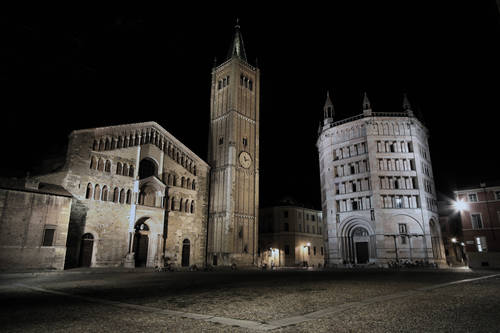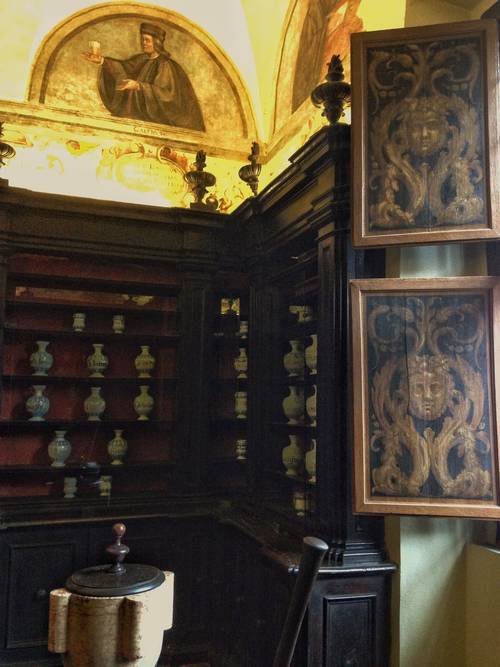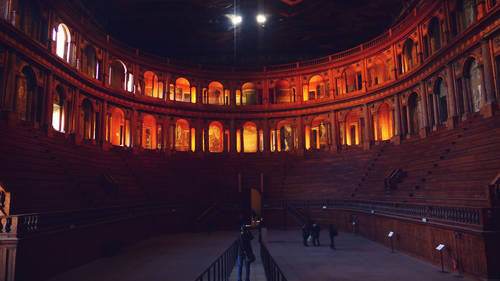Parma
Between Antelami, Correggio and Parmigianino
Parma is characterised by a quite interesting past, which stretches from the gorgeous medieval monuments to the beauties painted by Correggio and Parmigianino. The most flourishing time of that past happens during the Farnese dynasty and the following one, the Bourbon from Parma. The latter reigned over the dukedom of Parma-Piacenza, which was separated from the Pontifical State by pope Paolo III in favour of his own son. Its fascine, still tangible, was magnificently described by Stendhal in his Certosa di Parma.
Departure is planned at 8 in the morning, and the bus will be waiting at the cross between Paleocapa Street and Jacini Street.
Arrival to Parma and visit to its splendid Duomo in Romanesque style, with a façade introduced by a prothyrum laying on lions and covered by a niche; the part under the arch of the prothyrum shows the representation of the months. Inside of the church, the frescos of the dome are painted by Correggio (1526-1530) and depict the Assunzione della Vergine, working as an excuse for allowing a steep ascendant move; in the transept on the right, the Deposizione dalla Croce (1178) stands as the masterpiece by the Romanesque sculptor Benedetto Antelami.

Duomo – CC BY 3.0 | Filippo Aneli | 2009-08
Next to the Duomo rises the Baptistery, done with the pink marble from Verona; it is a Romanesque-Gothic element with an octagonal layout. In the lower part of it are the three portal reliefs, which together with some of the decorations and the statues inspired to Byzantine models represent one of the most significant legacies of Romanesque sculpture. The inside of the Baptistery is influenced by Byzantine art, and holds a notable cycle of frescos showing the life of Jesus and the Golden Legend. The overall plastic decoration, with its famous extremely high relief sculptures of the months, seasons and horoscope signs, belongs to the Antelami and his fellows.
Visit to Chiesa di S. Giovanni Evangelista, a Renaissance structure (1510). Inside is preserved the notorious cycle of frescos by Correggio (1520-23) and by Parmigianino which covers the compartment of the dome (Visione di S. Giovanni nell’isola di Patmos in the dome, the Padri della Chiesa and Evangelisti in the plumes, finally biblical heroes in the under arches parts). The ‘500 inlayed choir, the sacristy with carved armoirs dating back to the principle of the 1500 and the ‘500 cloisters of the monastery all shine for their beauty. The Antica Spezieria di S. Giovanni Evangelista is set beside the church; it is a Benedictine pharmacy founded in 1201 and active till 1766, which still preserves the 16th-17th centuries furniture.

Antica Spezieria – CC0 | pensierarte | 2016
Visit to the Madonna della Steccata, a church built in the ‘500 by Bernardino e Giovan Francesco Zaccagni and hosting precious frescos belonging to the parmense (of Parma) school active in the ‘500, among which the beautiful cycle by Parmigianino (Vergini stolte and Vergini sagge). In the crypt are placed the tombs of the Farnese and Bourbon from Parma dynasties.
Lunch is individual.
In the afternoon visit to the notorious Camera di San Paolo, small jewel of the Renaissance painting, situated inside of the ex monastery of S. Paolo and completed between 1519 and 1520 by Correggio; the room originally belonged to the private apartment owned by the client, the abbess Giovanna da Piacenza. Correggio conceived a classic and mythic decoration for the room, sustained by a structure of naturalistic elements: the vault has an umbrella shape, divided in 16 wedges, and turned by the pictorial fiction into an arbour with Putti placed within roundels and with classic figures in the lunette.

Teatro Farnese – CC BY 2.0 | Alessandro Bonvini | 2015
Visit to the group of the Palazzo della Pilotta, austere building done under the Farnese between 1583 and 1622. It derives its name from the ‘pelota’ game, which used to be played in the courtyards. The group is made up of the Museo Archeologico, the Galleria Nazionale, the Biblioteca Palatina and the beautiful Teatro Farnese, which is the perfect reproduction (1950ies) of the imposing original one, which was built entirely in wood in 1619 by G.B. Aleotti, and then destroyed almost totally because of a fire in 1944. The core of the rich collection of the Galleria Nazionale was organised in 1752 by the dukes of Parma, the Bourbon Filippo and Ferdinando; later Maria Luigia from Austria added her acquisitions. Among the pieces in the collection there are important works by the Emiliana, Toscana and Veneta schools from the ‘300 to the ‘500, realised by artists such as Fra Angelico, Canaletto, Bellotto, Tiepolo, Parmigianino (Schiava Turca, Autoritratto) and by Correggio (Madonna del San Girolamo, Madonna della Scodella, Incoronata, Madonna della Scala).
Back to Milan by more or less 8.30 PM.